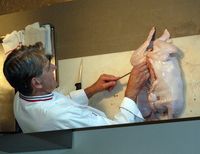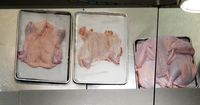04 Nov Hunting and Gathering: Turducken for Thanksgiving
Why did the turducken cross the road? Probably to outrun its reputation. Just saying “turducken” out loud has me smirking. And recollecting “The Daily Show” a while back when it was suggested that the Kurds, Iraq and Turkey should gather together to form a new nation called Turducken.
Picture the turducken and you imagine a mythical creature that might resemble a cross between the Harry Potter hippogryph and the hapless dodo, a bird that lumbers around not really sure of what it is.
It isn’t clear who first thought up the idea of stuffing a turkey with a duck and a chicken, but most likely it was a playful butcher at Hebert's Specialty Meats in Maurice, Louisiana, who first offered the meat for sale sometime in the 1980’s. The great chef Paul Prudhomme, known for the excesses of his cooking style as well as his girth, is the man who popularized it so that it is now a signature dish at many Thanksgiving tables and Superbowl parties. 
The idea of playing Russian dolls with different animals to create a dish is actually pretty old. The 1807, the Almanach de Gourmands, written by Grimod de La Reynière, one of the world’s first food reviewers and critics, describes a stunningly excessive concoction called Rôti sans Pareil, or Roast without Equal: a bustard (sort of a flying dodo) stuffed with a turkey, a goose, a pheasant, a duck, a chicken, a guinea fowl, a teal, a woodcock, a partridge, a plover, a lapwing, a quail, a thrush, a lark, an ortolan bunting and a garden warbler, the last of which is stuffed with a single olive.
In a bid to confer greater respect on the dish, the Institute of Culinary Education teaches a demonstration class titled Turducken: The Indulgence of the Louisiana Kitchen in which Master Butcher Rudi Weid makes the whole process look deceptively easy and convincingly worth a try.
Using a knife that has been honed by years of grinding into a sliver of its former self, Weid deftly debones the turkey, duck and chicken in front of an audience until all that is left is the intact flesh of each bird. He has had lots of practice, but the real secret to removing all the bones without mangling the meat or piercing the skin is patience. “None of the other butchers [I worked with] would do it”, he says. If you want to try to make this dish yourself “Don’t be in a hurry” he advises. “It’s going to fight back. And its going to win!”
If you don’t want to play Frankenstein by trying to make a turducken yourself, the best ones can be ordered directly from Cajun Gocery according to the Institute of Culinary Education and the Wall Street Journal, which ran a taste test of different mail order birds in 2004.
When you roast your bird, Rudi Weid suggests ignoring the recipes that advise high temperatures and cook it for ten hours at 190 degrees. That way the fat will be slowly rendered and the meat will stay juicy. Chef Paul Prudhomme shares his recipe and a photo of a perfectly cooked turducken here.
Lisa Barlow is a food columnist for Telluride Inside…And Out.



Sorry, the comment form is closed at this time.